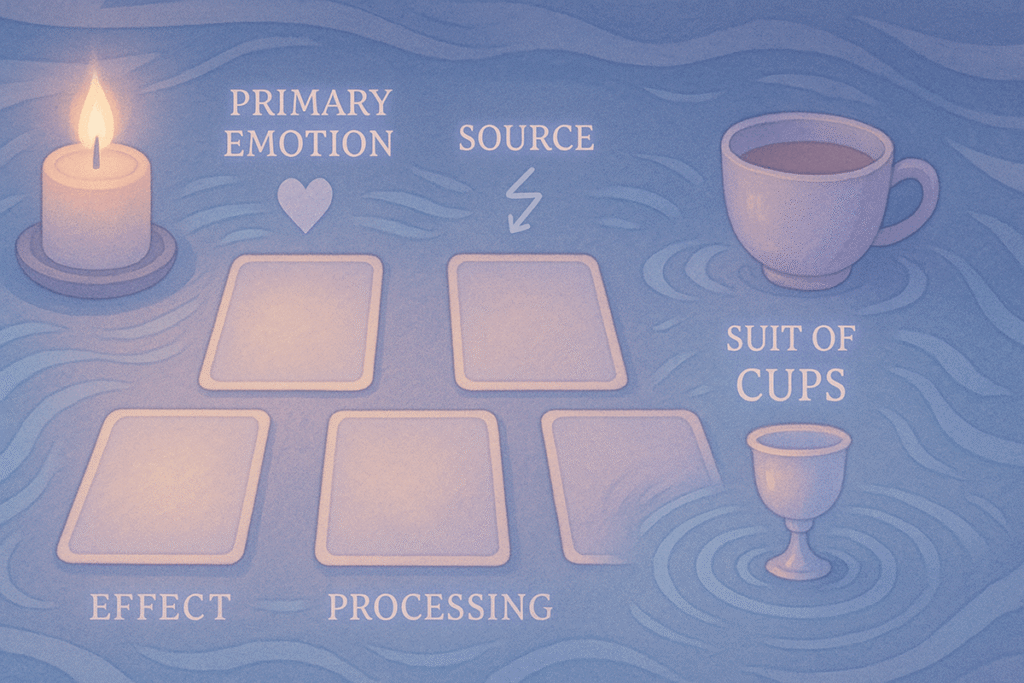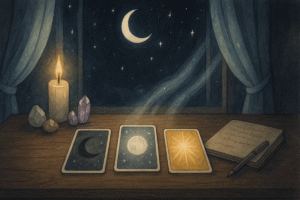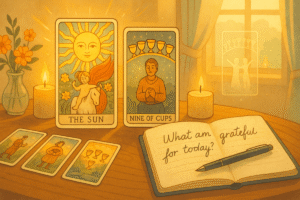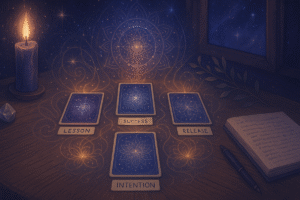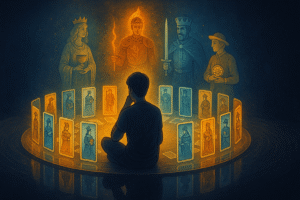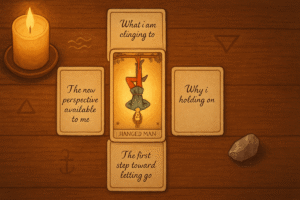Table of Contents
Sometimes I catch myself wondering why certain emotions feel so overwhelming while others seem to pass by like gentle breezes. Perhaps you’ve experienced this too—those moments when feelings bubble up from nowhere, leaving you searching for understanding rather than quick answers.
Tarot offers us a unique opportunity to sit with our emotions, not to predict what they mean for our future, but to explore what they might be teaching us right now. Today, I’d like to share a simple four-card spread that invites you to look inward and discover what your emotional landscape might be revealing.
Understanding Emotions Through Tarot
Working with emotions through tarot isn’t about finding definitive answers or receiving messages from beyond. Instead, it’s more like having a conversation with different parts of yourself. When we draw cards with the intention of exploring our feelings, we’re essentially creating space for reflection that might not otherwise happen in our busy daily lives.
I’ve found that emotions often carry information we need, even when they feel uncomfortable or unwelcome. A sudden wave of anxiety might be pointing toward something that needs our attention. That unexpected surge of sadness could be connected to a loss we haven’t fully processed. Joy, too, has its own wisdom to offer about what truly nourishes us.
The beauty of using tarot for emotional exploration lies in its ability to slow us down. Instead of rushing to fix or change how we feel, we can pause and ask gentler questions. What is this emotion trying to tell me? How might it be serving me, even if it doesn’t feel pleasant?
This approach aligns beautifully with modern therapeutic practices that encourage us to befriend our emotions rather than battle them. Tarot becomes a tool for curiosity rather than judgment.
The Four Card Emotional Exploration Spread
This spread uses four positions, each designed to help you explore a different aspect of your current emotional experience. I like to think of it as creating a gentle map of your inner world, one that helps you navigate with compassion rather than criticism.
Position 1: The Primary Emotion I’m Experiencing This first card invites you to identify what emotion feels most present for you right now. Sometimes we think we know what we’re feeling, but the card might reveal layers we hadn’t noticed. Perhaps you thought you were angry, but the card suggests hurt underneath that anger.
Position 2: The Source or Root of This Emotion The second position helps you explore where this feeling might be coming from. This isn’t about assigning blame or finding someone to fault. Instead, it’s about understanding the soil in which this emotion has grown. Maybe it’s connected to a recent conversation, an old memory that surfaced, or even a change in your environment.
Position 3: How This Emotion Is Affecting Me This card examines the ripple effects of your emotional state. How might this feeling be influencing your thoughts, your interactions with others, or your daily choices? Sometimes emotions affect us in ways we don’t immediately recognize.
Position 4: A Healthy Way to Process This Emotion The final position offers gentle guidance on how you might work with this emotion in a nurturing way. This could suggest anything from creative expression to having an honest conversation, from spending time in nature to simply allowing yourself to feel without needing to act.
The Suit of Cups and Emotional Wisdom
When exploring emotions through tarot, you might find that cards from the Suit of Cups appear frequently in your readings. This makes perfect sense, as Cups traditionally represent the realm of emotions, intuition, and relationships in tarot.
The Ace of Cups might appear when new feelings are emerging, suggesting an opportunity for emotional renewal or the beginning of a deeper understanding of yourself. The Two of Cups could indicate that your emotions are connected to your relationships with others, perhaps highlighting the need for emotional reciprocity or deeper connection.
If the Three of Cups shows up, your emotions might be calling for community, celebration, or sharing your feelings with trusted friends. The Four of Cups sometimes suggests emotional stagnation or the need to shift perspective on a situation that’s been troubling you.
Each Cup card carries its own emotional signature, but remember that their appearance in your spread isn’t a definitive statement about your situation. Rather, they offer symbolic language for exploring what you’re experiencing. A Cup card might resonate immediately, or it might take some contemplation to understand its relevance to your emotional state.
Creating Sacred Space for Your Reading
Before you begin your emotional exploration, I encourage you to create a environment that feels safe and nurturing. This might mean lighting a candle, playing soft music, or simply ensuring you won’t be interrupted for the next fifteen or twenty minutes.
There’s something powerful about treating this practice with gentle ceremony. It signals to your subconscious that you’re entering a space of self-reflection and care. I’ve noticed that when I approach tarot with this kind of intentionality, the insights that emerge feel more meaningful and applicable to my life.
You might want to have a journal nearby to write down thoughts that arise during or after your reading. Sometimes the most valuable insights come not from the cards themselves, but from the feelings and memories they evoke as you contemplate their imagery and symbolism.
Working With Difficult Emotions
Perhaps the emotions you’re exploring feel overwhelming or painful. If challenging feelings emerge during your reading, remember that the goal isn’t to fix or eliminate them immediately. Instead, you’re practicing being present with whatever arises.
Sometimes the most healing thing we can do is simply acknowledge what we’re feeling without trying to change it right away. The card in position four might suggest ways to care for yourself while you’re experiencing difficult emotions, rather than ways to make them disappear.
I think there’s wisdom in allowing emotions to move through us like weather systems. They arrive, they peak, and eventually they pass. Tarot can help us track these emotional weather patterns with curiosity and compassion rather than resistance.
If you find yourself feeling more upset after a reading, it might be helpful to reach out to a trusted friend, counselor, or mental health professional. Sometimes emotions that have been buried need more support than we can provide for ourselves, and that’s perfectly normal.
Integrating Insights From Your Reading
After you’ve completed your four-card spread, spend some time sitting with what emerged. You might notice connections between the cards that weren’t immediately obvious, or find that one particular image or symbol keeps drawing your attention.
I often find it helpful to ask myself follow-up questions based on what the cards revealed. If the reading suggested that my primary emotion is connected to feeling unsupported, I might ask, “What kind of support do I really need right now?” or “How can I better support myself?”
The goal isn’t to have everything figured out by the end of your reading. Emotional understanding often unfolds gradually, and the insights from your tarot exploration might continue revealing themselves over the days or weeks that follow.
Regular Emotional Check-Ins
You might find this spread helpful to revisit periodically, perhaps weekly or whenever you notice your emotional landscape shifting significantly. I’ve discovered that tracking emotional patterns over time can reveal interesting themes and cycles that aren’t visible in a single reading.
Some people prefer to use the same spread regularly, while others like to modify it based on their current needs. You might add a fifth card asking, “What emotion wants to emerge?” or substitute position three with “What is this emotion teaching me?”
The beauty of working with tarot for emotional exploration is that it adapts to wherever you are in your journey. There’s no right or wrong way to interpret what emerges, only opportunities for deeper self-understanding and compassion.
Your emotions are valid messengers, deserving of attention and care. This tarot spread simply offers one pathway for listening to what they might be trying to tell you, with gentleness and without judgment.
Frequently Asked Questions
What if the cards I draw don’t seem to match the emotion I think I’m feeling?
This actually happens more often than you might expect, and it can be one of the most valuable aspects of working with tarot for emotional exploration. Sometimes we tell ourselves we’re feeling one thing when there’s actually a different emotion underneath. If you pulled cards expecting to explore anger but the spread suggests sadness or hurt instead, that’s worth paying attention to. Your conscious mind might have one interpretation of your emotional state, while the cards are inviting you to look a layer deeper. Give yourself permission to sit with the unexpected message rather than dismissing it immediately.
Should I do this reading when I’m feeling very upset or overwhelmed?
There’s no absolute rule here, but many people find it helpful to take a brief pause before doing emotional work with tarot when they’re in an intense state. Perhaps take a few deep breaths, have a glass of water, or step outside for a moment. This isn’t about suppressing your feelings, but rather creating just enough space so you can approach the cards with curiosity instead of desperation for specific answers. That said, if you do read while upset, be gentle with yourself about the interpretation. You might find it helpful to revisit the reading later when you’re feeling more grounded to see if any new insights emerge.
Can I use this spread to explore positive emotions too, not just difficult ones?
Absolutely. Joy, excitement, contentment, and other pleasant emotions deserve exploration just as much as challenging ones. Understanding where your happiness comes from and how it’s affecting you can help you cultivate more of it in your life. You might be surprised by what position four reveals about nurturing positive emotional states. Sometimes we need permission to fully feel our joy without waiting for the other shoe to drop, and this spread can help with that.
What if I draw mostly Cups cards but they don’t seem to directly answer my questions?
When multiple Cups appear in an emotional reading, it’s often a sign that you’re deeply engaged with your feelings, which makes sense given the nature of this spread. Rather than looking for each card to provide a literal answer, try noticing the emotional journey the cards create together. How does the feeling in the first card evolve or shift through positions two, three, and four? Sometimes the pattern across the spread reveals more than individual card meanings. Also remember that other suits appearing alongside Cups can add important dimensions. Swords might highlight how your thoughts are interacting with your emotions, while Wands could suggest the passionate or creative energy underneath your feelings.

